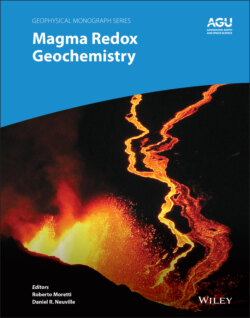Читать книгу Magma Redox Geochemistry - Группа авторов - Страница 25
2.2.1. The Solar Nebula Redox State The fO2 of Chondrites.
ОглавлениеThe redox condition of the early accretion was set by the Solar Nebula environment and the intrinsic fO2 of the building blocks. The in meteorites represent the first crystalline materials that condensated in equilibrium with the gaseous Solar Nebula (Bouvier & Wadhwa, 2010). These inclusions are made of refractory minerals like spinel, fassaite‐like, melilite, perovskite, and anorthite, formed according to their condensation temperature (Grossman, 1972). They record, therefore, the redox state of the Solar Nebula, which is defined as the fO2 at which the Solar Nebula vapor phase and the condensed mineral assemblage were equilibrated. Important fO2 indicators are represented by those elements with multiple oxidation state (e.g., Fe and Ti). The relative abundance of the species with different oxidation state (e.g., the Ti3+/Ti4+ ratio in pyroxene) correlates with the fO2 largely buffered by the relative abundances of carbon, oxygen, and hydrogen in the cosmic gases. The application of the Ti3+/Ti4+ ratio in pyroxenes is based on the experimental calibration of the following equilibria (Grossman et al., 2008)
(2.1)
and
(2.2)
These two oxy‐thermometers resemble the assemblage found in CV3 Allende meteorite and allow us to determine its fO2, calculated at 1500 K and 10–3 atm, to be between ~–10 and –7 log units as normalized to the oxygen buffer (Fig. 2.1) (Allende Prieto et al., 2002). At these low fO2, metallic Fe stably alloys with Ni over a wide temperature range. However, the occurrence of fayalitic (i.e., Fe as Fe2+) olivine inclusions in chondrules of ordinary chondrites (Fe# of 0.15) implies the presence of oxidized regions in the Solar Nebula. This heterogeneity in fO2 of the Solar Nebula has been explained by the input of oxidized materials from beyond the snow line. This resulted in a local increase of the bulk oxygen content accounting for a fO2 of IW‐4.5, although an additional contribution of oxidized chondritic material cannot be discounted (Grossman et al., 2012; Rubie et al., 2015). A further fO2 increase by 5–6 log units is recorded by rims of CAI inclusions from some CV3 meteorites (e.g., Allende & Leoville meteorites; Wark & Lovering, 1977) showing a refractory assemblage (i.e. spinel, perovskite, hibonite, melilite, Al‐rich cpx, and forsterite) from which fO2 can be estimated through the application of Mg isotopes (i.e. 25Mg/24Mg) as a cosmo‐barometer, and the Ti3+/Ti4+ ratio in pyroxene. Such an fO2 increase was estimated to occur over 100–300k years and marks the formation of disks consisting of chondritic dust from which proto‐planets formed (Wark & Lovering 1977).
Figure 2.1 Range of oxygen fugacity estimates for Solar Nebula, achondrites, chondrites, and terrestrial planets (modified from Righter et al., 2016). The range of fO2 of the Martian mantle refers to the intrinsic measurements of fO2 in Martian basalts, while the fO2 of Earth’s mantle includes data for continental mantle xenoliths, abyssal peridotites, MORBs, arc lavas, and lamprophyres (Frost and McCammon, 2008).
